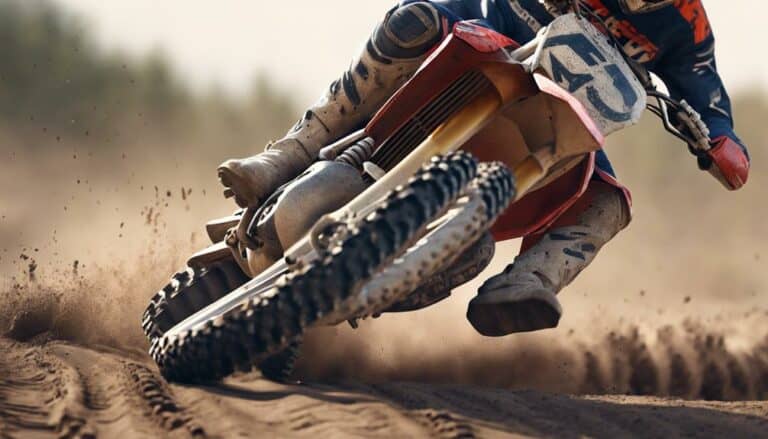When it comes to dirt bike riding, understanding how braking fundamentals contribute to your overall performance is like having a compass in uncharted territory. Imagine the thrill of conquering challenging terrains with finesse and precision.
But, what makes mastering braking techniques so pivotal in this adrenaline-fueled sport? Stay tuned to uncover the secrets behind how controlling your speed, timing your maneuvers, and finding the perfect balance can elevate your dirt bike riding experience to new heights.
Key Takeaways
- The attack position enhances control, stability, and performance during braking maneuvers.
- Downshifting optimizes braking efficiency by matching gear to speed for smoother deceleration.
- Optimal foot positioning improves stability, weight distribution, and braking control on different terrains.
- Balancing front and rear brakes prevents wheel lock-up, stabilizes the bike, and enhances overall control and performance.
The Attack Position Importance
In dirt bike riding, mastering the attack position is essential for optimizing braking control and overall performance. The attack position plays a critical role in enhancing braking technique as it allows for better control and responsiveness. By aligning your body with the bike in the attack stance, you secure ideal balance, which is key to maintaining stability during sudden braking maneuvers. This alignment not only improves control but also prepares you to swiftly switch from braking to acceleration, ultimately maximizing the bike's handling capabilities.
When you're in the attack position, your center of gravity is positioned in a way that boosts balance and control over the bike. This translates to a more stable and responsive ride, enabling you to handle challenging terrains and obstacles with greater ease. The importance of the attack position goes beyond just braking; it significantly enhances your overall riding experience by providing a solid foundation for improved performance and maneuverability. Mastering this fundamental body position is fundamental for any dirt bike rider looking to elevate their skills and enjoy a liberated riding experience.
Downshifting for Better Braking
Maximizing your braking efficiency on a dirt bike involves mastering the art of downshifting for best control and deceleration. Downshifting before braking engages engine braking, utilizing the resistance from the engine to slow down the bike effectively. This technique not only enhances control during braking but also matches the gear to the speed and terrain, ensuring best deceleration. Understanding the relationship between downshifting and braking is important for maintaining stability and control, especially on challenging dirt tracks.
Smooth and preemptive downshifting before braking is key to preventing engine stalling and ensuring a seamless switch to lower speeds. By mastering downshifting techniques, you can maximize braking performance and retain momentum during cornering and technical sections. Proper downshifting contributes importantly to overall riding performance by providing a smoother and more controlled braking experience, ultimately enhancing your ability to navigate through various terrains with precision and finesse.
Optimal Foot Positioning Techniques
To enhance your braking performance on a dirt bike, mastering ideal foot positioning techniques is important for stability, balance, and control.
Proper foot positioning, such as sliding the foot slightly forward with a locked knee, enhances stability and balance during braking. Critical foot positioning supports control by optimizing weight distribution and leverage on the bike during braking.
Effective foot positioning allows riders to maintain stability and control while applying brakes on varying terrain. Placing the foot correctly on the foot peg improves braking efficiency and reduces the risk of losing balance or control.
Skillful foot positioning enhances braking performance by maximizing contact with the foot peg for increased control and stability. By honing your foot positioning skills, you can improve your overall braking skills, ensuring a smoother and more controlled riding experience.
Gripping Knees for Control
Mastering the technique of gripping your knees while riding a dirt bike is pivotal for enhancing control and stability, especially during braking maneuvers. By using your knees to grip the bike, you can make the rear and front brakes work harmoniously, distributing the amount of pressure effectively. This technique is essential for maintaining the right riding position and preventing the bike from sliding or losing balance during braking. Gripping your knees not only helps in utilizing the front brake alone but also aids in learning how to use both brakes together without compromising stability. The table below illustrates the importance of gripping your knees for control and stability during braking:
| Benefits of Gripping Knees for Control |
|---|
| Enhances control and stability |
| Distributes weight effectively |
| Maintains a strong connection with the bike |
| Reduces arm fatigue |
| Improves confidence and responsiveness |
Balancing Front and Rear Brakes
When riding a dirt bike, achieving peak braking performance necessitates a delicate balance between utilizing the front and rear brakes simultaneously. To effectively balance front and rear brakes, consider the following:
- Using both front and rear brakes together stabilizes the bike during braking, preventing nose diving or stalling.
- The rear brake acts as an anchor by pressing the tire for stability while the front brake provides additional stopping power.
- Balancing brake application is essential to prevent wheel lock-up and maintain control on varying terrains.
- Moderate rear brake application causes wheel chatter, enhancing stability and control during braking.
Conclusion
You have learned how mastering braking fundamentals can greatly enhance your performance in dirt bike riding.
Did you know that professional riders can reduce their braking distance by up to 25% through precise control and timing techniques?
By implementing the attack position, downshifting effectively, optimizing foot positioning, gripping knees for control, and balancing front and rear brakes, you can improve your bike control, traction, and overall performance on challenging dirt tracks.
Keep practicing and pushing your limits!

